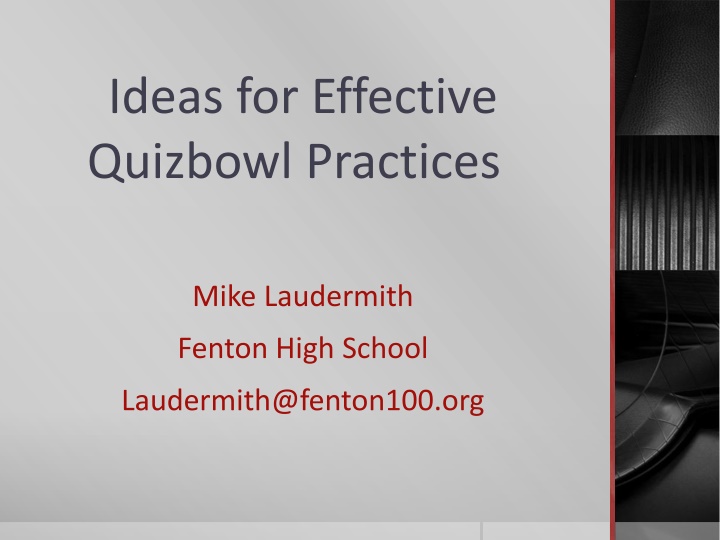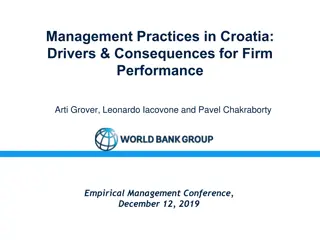
Effective Quizbowl Practice Strategies by Mike Laudermith Fenton High School
Discover effective quizbowl practice strategies outlined by Mike Laudermith from Fenton High School. Learn how to structure practices, enhance learning, and engage players for better performance in quizbowl competitions.
Download Presentation

Please find below an Image/Link to download the presentation.
The content on the website is provided AS IS for your information and personal use only. It may not be sold, licensed, or shared on other websites without obtaining consent from the author. If you encounter any issues during the download, it is possible that the publisher has removed the file from their server.
You are allowed to download the files provided on this website for personal or commercial use, subject to the condition that they are used lawfully. All files are the property of their respective owners.
The content on the website is provided AS IS for your information and personal use only. It may not be sold, licensed, or shared on other websites without obtaining consent from the author.
E N D
Presentation Transcript
Ideas for Effective Quizbowl Practices Mike Laudermith Fenton High School Laudermith@fenton100.org
Practice Essentials Supply every player with a notebook, pen, and some index cards. Good players write down the answers they don t get in practice so they can study them later. Make players bring their notebooks to matches/tournaments so they can review and write down new information. Putting clues and answers on index cards allows players to quiz each other anywhere. Have a practice agenda with a variety of activities. Just reading questions for 90 minutes gets monotonous and isn t the best way to learn. If feasible, have Varsity players practice separately from the Frosh-Soph team. In any case, have practice materials on hand for all player levels. www.quizbowlpackets.com has a wide range of question difficulty to choose from.
A Typical Fenton Practice 1. Warm-up on shorter, easier questions. (10-15 minutes) I ve used NAQT Speed Checks, the last sentences of tossups from novice sets, and various middle school sets. Everyone gets one buzz per question and when you get _____ right, you have to put your buzzer down. 2. Players read tossups they have written. (5-10 minutes) 3. Coach s lesson of the day, usually in the form of a Top 10 list. (15-20 minutes) Players take turns reading and are required to take notes in their notebooks. I make Top 10 lists available in a shared Google folder. 4. 1-on-1 practice time. (20 minutes) This is the point at which I would separate the Varsity and F/S teams. Players are paired up and each is given a question packet of appropriate difficulty. They must take turns reading questions to each other, writing down missed answers. 5. Mock Match. (25-30 minutes) Practice like you play! Enforce the rules that will be used in upcoming matches/tournaments. Try to divide players into evenly matched teams. 6. End on a fun note. (5-10 minutes) I like to end practices with something quick and fun. I ve done NAQT Lightning Rounds and various trash sets, and use Sporcle quite often.
Other Ways to Enhance Practices Do some tossup dissections. Type a tossup of at least 3-4 lines into a PowerPoint slide, but animate it such that each clue appears only when you click. After each clue, ask the players to narrow down the topic of the question and make predictions for possible answers. Write these on the board. Ask them to think of additional clues that could appear which would specifically point to a mentioned answer. If any student knows the answer early on, he/she should write it down but not say it aloud. Cross possible answers off the board as new clues appear. Get players to recognize that most tossups have a point where they could guess with 50% certainty, 75%, 90%, etc. Hold a practice entirely dedicated to one subject. Invite in a guest lecturer to conduct the Coach s Lesson. I ve had guests (teachers) speak on Earth science, military history, classical music, and important math theorems.
Lets dissect this tossup In this novel, a mechanic claims a dog leash is evidence of his wife s cheating. This novel s narrator discusses tennis shoes over the phone with Klipspringer and sees his cousin sob over a pile of (*) shirts. George shoots a resident of West Egg in this work, whose protagonist claims to have run over Tom s lover with a car to throw suspicion off Daisy Buchanan. For 10 points, name this novel, narrated by Nick Carraway and written by F. Scott Fitzgerald. Answer: The Great Gatsby
Lets dissect this tossup This man commanded a patrol boat sunk by the Amagiri, PT-109, during World War II. This author of Profiles in Courage declared "I am the Democratic Party candidate for President who happens to be a (*) Catholic," and at his inauguration, he called on Americans to "ask not what your country can do for you; ask what you can do for your country." For 10 points, name this U.S. President who was assassinated by Lee Harvey Oswald. Answer: John Fitzgerald Kennedy
Ways to Get Players to Prepare Outside of Practice Develop Individualized QuizBowl Plans (IQBP) for your players. (See attached) Type a list of missed answers from a recent tournament. Assign each player a certain number to research (usually 3 clues). They will present them to the team at the next practice. (See attached) Research Top 10 Lists. (See attached) Prepare a list of 10 answers you want your players to know but assign them to do the legwork and present at the next practice. www.studystack.com http://protobowl.com/hsquizbowl www.quinterest.org WHOOZIT?
Recruiting & Retaining Players Mike Laudermith Fenton High School Laudermith@fenton100.org
Connecting with Feeder Schools See article from Scholastic Visions, Sept 2012. Each January, Fenton hosts an informal workshop/scrimmage for our 2 feeder middle schools, run mostly by the Fenton players. For the first half, the MS students picked mini-sessions to attend where Fenton players taught them clues from their areas of expertise (lit, science, history, etc.). Each session was only about 10 minutes. For the second half, teams from each school scrimmaged against each other on a MS question set. Fenton players had earlier prepared their own questions from their session materials and I slipped some of these into the packets.
Recruiting High School Players My team has its own bulletin board in a heavily trafficked hallway. From the first day of school, I printed some easier questions and attached them to the board with post-it notes covering the answers. This gives students a taste of what Scholastic Bowl is like. In the center of the board was a flyer announcing the date of our season kickoff meeting and a sign-up sheet below it. About 3 weeks before our season kickoff meeting, I put a flyer on every bulletin board in the school. I make sure the meeting is mentioned in the daily announcements as well. At the Freshmen Orientation meeting before the school year began, freshmen were given a form to mark with the sports and activities they might be interested in joining. Those results are compiled and sent to every coach and sponsor. Students indicating interest in Scholastic Bowl are sent an individual invitation from me to attend the kickoff meeting.
Recruiting High School Players About 2 weeks before the kickoff meeting, I ask the freshmen honors teachers in my department for names of students with quizbowl potential. I send them an individual invitation as well, specifically saying they were recommended by their teacher to join the team. Each year I ask my returning players to encourage their classmates to come see what the team is like.
Retaining Players on Your Team #1 Tip Make your activity worth a student s time and effort. Your attitude and demeanor as a coach matters if you project that Scholastic Bowl is a genuine competition, celebrate student achievements, and foster an atmosphere of team pride, players will internalize these values and commit to the activity. Add Saturday tournaments to your schedule so that players get the maximum opportunities to play. Be sure your team and players get the recognition they deserve at the school and in the community.
Retaining Players on Your Team Make your practices about increasing player knowledge and building camaraderie, not establishing cliques or stroking individual egos. For at least part of every practice, I have F/S players separate from my varsity team. I find some varsity players enjoy clubbing baby seals a bit too much, and no one wants to be part of a group where they are always made to feel inadequate. Players naturally tend to focus on things like the awesome power TU they just scored or their teammate s bad neg. Dwelling too much on this, though, can hurt the cohesiveness of the team. I always try to pull the conversation back to great, now tell us how you learned that clue or what do we still need to learn so that our team doesn t miss that TU next time? .
Retaining Players on Your Team End the regular season on a high note with a party/banquet/outing of some kind. I prepare a little brochure for this in which I highlight each players achievements for the year, not just their stats but the ways they have positively contributed to the team and personally grown as players. Stay in touch with your players outside of the competition season. I am always sending my players suggestions for books to read, great websites for studying, and notices for further opportunities like ACE Camp.




















